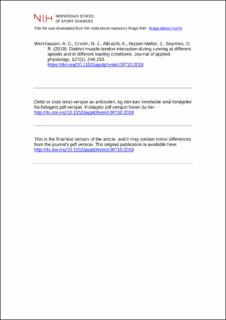| dc.contributor.author | Werkhausen, Amelie | |
| dc.contributor.author | Cronin, Neil J. | |
| dc.contributor.author | Albracht, Kirsten | |
| dc.contributor.author | Bojsen-Møller, Jens | |
| dc.contributor.author | Seynnes, Olivier R. | |
| dc.date.accessioned | 2020-07-08T06:21:43Z | |
| dc.date.available | 2020-07-08T06:21:43Z | |
| dc.date.created | 2019-08-27T11:53:10Z | |
| dc.date.issued | 2019 | |
| dc.identifier.citation | Journal of applied physiology. 2019, 127(1), 246-253. | en_US |
| dc.identifier.issn | 8750-7587 | |
| dc.identifier.uri | https://hdl.handle.net/11250/2661326 | |
| dc.description | I Brage finner du siste tekst-versjon av artikkelen, og den kan inneholde ubetydelige forskjeller fra forlagets pdf-versjon. Forlagets pdf-versjon finner du på journals.physiology.org / In Brage you'll find the final text version of the article, and it may contain insignificant differences from the journal's pdf version. The definitive version is available at journals.physiology.org. | en_US |
| dc.description.abstract | The interaction between the Achilles tendon and the triceps surae muscles seems to be modulated differently with various task configurations. Here we tested the hypothesis that the increased forces and ankle joint work during running under contrasting conditions (altered speed or load) would be met by different, time-dependent adjustments at the muscle-tendon level. Ultrasonography, electromyography, kinematics, and ground reaction force measurements were used to examine Achilles tendon, gastrocnemius, and soleus muscle mechanics in 16 runners in four different running conditions, consisting of a combination of two different speeds (preferred and 20% of preferred speed) and two loading conditions (unloaded and 20% of body mass). Positive ankle joint work increased similarly (13%) with speed and load. Gastrocnemius and soleus muscle fascicle length and peak velocity were not altered by either condition, suggesting that contractile conditions are mostly preserved despite the constraints imposed in this experimental design. However, at higher running speed, tendon length changes were unaltered but mean muscle electromyographic activity increased in gastrocnemius (10%, P 0.01) and soleus (14%, P 0.01). Conversely, when loading was increased, mean muscle activity remained similar to unloaded conditions but the mean velocity of gastrocnemius fascicles was reduced and tendon recoil increased (29%, P 0.01). Collectively, these results suggest that the neuromuscular system meets increased mechanical demands by favoring economical force production when enough time is available. | en_US |
| dc.language.iso | eng | en_US |
| dc.subject | achilles tendon | en_US |
| dc.subject | load carriage | en_US |
| dc.subject | locomotion | en_US |
| dc.subject | muscle architecture | en_US |
| dc.subject | running | en_US |
| dc.title | Distinct muscle-tendon interaction during running at different speeds and in different loading conditions | en_US |
| dc.type | Peer reviewed | en_US |
| dc.type | Journal article | en_US |
| dc.description.version | acceptedVersion | en_US |
| dc.source.pagenumber | 246-253 | en_US |
| dc.source.volume | 127 | en_US |
| dc.source.journal | Journal of applied physiology | en_US |
| dc.source.issue | 1 | en_US |
| dc.identifier.doi | 10.1152/japplphysiol.00710.2018 | |
| dc.identifier.cristin | 1719061 | |
| dc.description.localcode | Seksjon for fysisk prestasjonsevne / Department of Physical Performance | en_US |
| cristin.ispublished | true | |
| cristin.fulltext | postprint | |
| cristin.qualitycode | 1 | |
